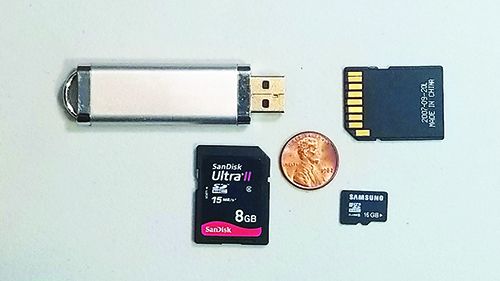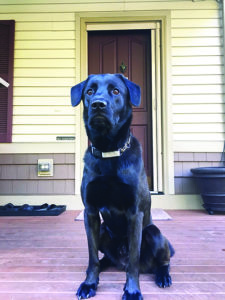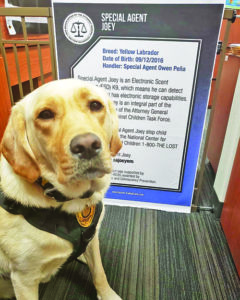
Humans have trained dogs to use their amazing noses to identify all kinds of things – explosives, illegal drugs, bedbugs, cancer, even ancient burial sites. But did you know that dogs can help police sniff out evidence against child pornographers?
It’s true! In 2015, after a lengthy investigation, the home of Subway franchise spokesman Jared Fogle was raided by FBI agents with the help of a black Labrador Retriever named Bear. At Fogle’s home, Bear indicated three finds by sitting in front of their locations, then pointing with his nose to each scent source. One of Bear’s finds was an incriminating thumb drive missed by human searchers containing evidence that helped send Fogle to jail.
For the record, electronic-storage detection dogs (ESD K9s) have no knowledge of the content stored on the devices they seek. They are often called porn-sniffing dogs because those who treasure illicit images usually save them on electronic-storage devices that are small and easy to hide.
A RELATIVELY NEW DOG JOB
In 2011 Jack Hubball, Ph.D., a chemist at the Connecticut Scientific Sciences Forensic Laboratory, discovered that electronic storage devices carry unique scents in their circuit board components, such as triphenylphosphine oxide (TPPO), which dogs can detect. Armed with that chemical key, Connecticut State Police began training Thoreau and Selma, dogs who were too active to complete their training at Guiding Eyes for the Blind in New York.
The officers started with large amounts of the chemical and gradually reduced its quantity, placing devices containing the odor in different boxes and eventually in different rooms. After five weeks of odor detection training and six weeks of training with his new handler, Thoreau, a yellow Lab, was given to the Rhode Island State Police. On his first official search, he discovered a thumb drive containing child pornography in a tin box inside a cabinet.
Selma, a black Lab, worked with the Connecticut State Police Computer Crimes Unit, where she uncovered devices in recycling bins, vents, and radiators while working on child pornography, homicide, parolee compliance, and computer hacking cases.
With those successes, an entirely new type of law-enforcement career for dogs was established.
STANDOUT DETECTIVE DOG
Bear, the dog who helped make the case against Jared Fogle, started life as a pet dog in a family who loved him – but who couldn’t prevent him from jumping on counter tops and eating everything he could reach. When he was 2 years old (the age at which many out-of-control dogs are surrendered to shelters), his owners offered him to Todd Jordan, an Indiana firefighter who trained dogs for arson investigations.

Instead of training Bear to detect fire accelerants, though, Jordan chose to help friends on the Internet Crimes Against Children (ICAC) task force, who were frustrated at not being able to find thumb drives and microSD cards when searching the homes of child pornographers. Inspired by the electronic-storage device detection dogs Thoreau and Selma, Jordan focused on developing Bear’s ability to detect tiny digital storage devices – th ekind that might be hidden in wall cracks, clothing, ceiling tiles, radios, closets, books, boxes, furniture, dirty laundry, or garbage.
Most search and rescue (SAR) dogs are rewarded with toys that satisfy their prey drive, but food was Bear’s favorite reward, and he was highly motivated. Jordan started training Bear in his own garage, hiding USB drives for Bear to find, and eventually began working with task force agents. Soon Bear and Jordan began accompanying detectives on warrant searches, where Bear found thumb drives missed by human searchers.
A few months after Bear’s successful search at Fogle’s home, he helped police gather evidence that led to the arrest of Marvin Sharp, a USA Gymnastics coach charged with possessing child pornography; Bear found microSD cards hidden inside Sharp’s gun safe.
In 2015, Seattle Police Department Detective Ian Polhemus, an eight-year member of the ICAC task force, went to Indiana to learn how to work with ESD K9s. Jordan matched Detective Polhemus with Bear, and not long after, sent Bear to live and work with Polhemus in Seattle. The new partners began sniffing out electronic evidence of crimes almost immediately. In one case, investigators completed their search of a suspect’s home and then Polhemus brought in Bear for another search. In just a few minutes, Bear located five devices, some of which contained child exploitation material, that the initial search team had missed.
Bear trains every day, Detective Polhemus explained in a 2018 KIRO Seattle radio interview. “Because he’s a food-reward dog, he’s highly motivated. So what that means is the only time he eats is when he’s working,” says Polhemus. Bear is fed three cups of food throughout the day, whether he’s working on a case or practicing.
“I’ve got three training boxes with holes in them and only one of them has a device in it that he should indicate on,” Polhemus says. “When he gets to the box that has a device in it, Bear is a passive indicator, which means he’ll sit. I’ll give him a supplemental command and then he’ll shove his nose in the hole and his tail will wag and he’ll sit there and hold his nose in the hole until I reward him with food.”
GROWING DEMAND
Illinois State Attorney Michael Nerheim became interested in ESD K9s when he learned about Bear’s success. “We were seeing a trend here where child pornographers, rather than downloading evidence onto a computer, would download evidence onto a removable device and then hide that device in their house,” he told the Chicago Tribune in 2018.
Subsequently, today, there are at least two ESDs trained by Todd Jordan working in Illinois. These dogs, named Browser and Cache, now work for the Lake and Will County attorney’s offices, respectively. Child exploitation cases are their main tasks, but the dogs can help with any crime that involves computers or computer records.
“Browser has assisted on dozens of search warrants,” says his handler, Carol Gudbrandsen, a cybercrimes analyst. “He routinely performs searches in the jails and has been performing sweeps with the Lake County Probation Department when they do home visits on their sex offenders. Browser and I also do presentations in the schools in Lake County, speaking on internet safety and cyberbullying to students, staff, and parents. When I bring Browser into these situations, he instantly grabs the attention of our audience, and our presentations have become even more effective.”
JOB REQUIREMENTS
To date, Todd Jordan has trained 30 ESDs and nearly two dozen accelerant-detection dogs at his business, Jordan Detection K9. Jordan adapts his training methods for dogs who are ball- or toy-driven, but his primary focus is passive-response (indicating by sitting quietly), food-reward training.
“Our canines are hand-picked, based on their willingness to please and their willingness to work,” he explains at his company’s website, electronicdetectionk9.com. “Most are second-career dogs. We also work closely with several Labrador rescues in order to give good dogs a chance at a fulfilling life.
“We select dogs with high energy and hunt drives. Many of the dogs have failed guide-dog or service-dog school because they may chase after small animals or bark at other animals or other people while working. Although those are instances where a canine would not be good for a person with special needs, they are still great for what we do.”
TRAINING METHODS
Some trainers of law-enforcement dogs use only toys and play as training reinforcers, and worry that using food for rewards opens the way for an abuse of the system, so to speak: that someone could use food to distract a law-enforcement sniffing dog. The human partners of dogs like Thoreau, Selma, Bear, Browser, and Cache beg to differ.
“I had prior canine handling experience with ball- and toy-driven dogs, and had no experience with food-driven canines,” says Special Agent Owen Peña at the New Mexico Office of the Attorney General. “Todd made a believer out of me for the advantages of using a food-driven canine for this type of work and breaking me of my old toy/ball-driven habits. With the canine being food-driven, I feel there is a better bond and connection that I and my family have with our canine, Joey. Now Joey is part of my family and he just happens to have a job.”

Like other electronic-storage detection dogs, Joey works with just one handler, food is an integral part of his daily practice, and he is well fed in the process. Because the dogs eat only when they find a device, their handlers run trainings every day to keep their skills sharp.
Do they actually offer false indications just so they can steal food? In 2016 Special Agent Jeffrey Calandra of the FBI’s Newark, N.J., Field Office started working with Iris, a black Lab, in cases involving organized crime, drug gangs, and cybercrimes including child pornography. In one search, FBI agents were confident that there was nothing left to find in a room with a desk, but Iris alerted to something in its top drawer. Calandra opened the drawer and didn’t see any evidence. When he said, “Show me,” Iris pushed her nose onto a pad of sticky notes.
Calandra assumed that Iris was faking her response so she could steal food, but when he pulled her away from the desk drawer, she pulled back. This time she picked up the pad of sticky notes with her mouth and flipped it over, causing a microSD card to fall out.
“She was correct and I was wrong,” said Calandra. “Either the individual was concealing it, or it got stuck in the pad and you just couldn’t see it. That’s why the dogs are so good.” False positives are not usually a problem, he added, explaining that he’s more concerned about the dog missing something, though he says that hasn’t happened yet.
IMPRESSIVE FUN
At the Connecticut State Police Forensic Laboratory, Jack Hubbell hopes to identify the lowest detectable scent levels of TPPO, measuring not only part-per-million levels but part-per-billion levels. The dogs’ noses are that impressive, he says, and they consistently out-perform any odor-detecting devices invented by humans.
As far as the dogs are concerned, finding evidence that helps police and the ICAC task force is a series of fun games and all in a day’s work.





